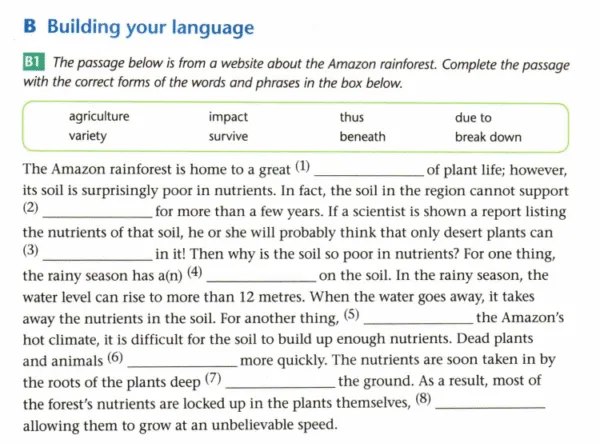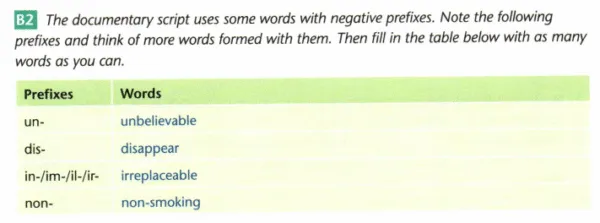所有课本上的练习:务必先做在活页练习本上(而不是课本上),再对比本页答案及答题解析。
A1 Write the main idea of each paragraph.
写出每段段落大意:
Para. 3: Layered structure creates several mini-habitats. 雨林分层,各层自成小世界
Para. 4: Jaguar food-chain shows forest connections. 以美洲豹为例展示食物链关系
Para. 5: “Lungs of Earth” but 17 % lost in 50 yr. 地球之肺,50年已毁17%
命题意图,解题技巧:
训练“scan→gist”能力:先抓 topic sentence(常为首句),再用自己的话压缩成名词短语或简单句,避免照抄原文。着重训练用不同的句子表达同样的事实。
A2 Fill in the blanks with the figures. 用数字填空
1 9
2 6,000,000 km²
3 6,400 km
4 40,000
5 1,300
6 400
7 20 %
8 17 %
解题技巧:
所有数字均按出现顺序集中在 Para.2 & Para.5,命题人让你“定位+精确值”。
注意同义改写:原文“more than half the size of China”并不对应任何填空,是干扰信息。
单位已给,只需写纯数字;但 6 400 必须写阿拉伯数字,加逗号(6,400)也接受。
第 8 题“about 17 per cent” 中的 about 可省,因题干已给“about”。
A3 Points for discussion. 讨论要点
1 Holds 1/10 world species, supplies 20 % O₂, potential medicines → natural treasure. 物种占全球1/10,供20%氧气,潜药源→天然宝藏
2 Can’t afford: already lost 17 %, extinction list growing, climate & drug security at risk. 已毁17%,濒危名单加长,气候与药物未来受威胁
3 China examples: Xishuangbanna, giant-panda habitat, Nonggang – rich species, intact ecosystem. 中国可比:西双版纳、大熊猫栖息地、弄岗——物种丰富,生态系统完整
完整回答如下:
What makes the Amazon a “natural treasure”?
It shelters one in ten of all known species, produces over 20 % of the planet’s oxygen, locks up huge amounts of carbon and contains thousands of plants that may become food or medicine.
物种占全球1/10,产20%氧气,固碳,千种植物可食用或入药。
Can we afford to damage it?
No. Another 17 % loss could push the rainforest past its tipping-point, accelerate climate change, shorten the list of life-saving drugs and cost far more than the short-term profits of cattle or soy.
再毁17%或越临界点,气候恶化,药源减少,长远损失远超短期农牧收益。
Any Chinese region with comparable biodiversity?
Xishuangbanna in Yunnan: tropical rainforest, Asian elephants, 5 000+ higher plants; or the Minshan mountains, home to wild giant pandas and 800 vertebrate species—both rich, intact and nationally protected.
云南西双版纳:热带雨林,亚洲象,5000+高等植物;岷山山系:野生大熊猫,800+脊椎动物,均物种丰富且受国家保护。
小结
A1 段落大意——考“首句+关键词”快速归纳。
A2 数字提取——考“scan for figures”+ 细心区分“约数/确数”。
A3 开放讨论——考“用文中证据支持观点”的学术规范,同时联系本土实例,培养迁移与思辨。

B1 Building yourlanguage
你需要从词汇框中选择正确的单词或短语填入空格。词汇框包括:
agriculture variety impact survive beneath due to beneath break down
填空解析
1. The Amazon rainforest is home to a great variety of plant life…
解析:表示“种类繁多的植物”,用名词 variety(种类)最合适。
2. …its soil is surprisingly poor in nutrients. In fact, the soil in the rainforest can only support agriculture for more than a few years.
解析:这是两个空格:
support(支持) 是动词,表示“支持农业活动”;
agriculture(农业) 是名词,表示“农业”。
3. …only desert plants can survive in it!
解析:表示“只有沙漠植物能在这种土壤中生存”,动词 survive(生存)最贴切。
4. …the rainy season has a(n) impact on the soil.
解析:雨季对土壤有影响,名词 impact(影响)是正确选择。
5. …due to the Amazon’s hot climate…
解析:表示原因,“由于亚马孙的炎热气候”,用短语 due to(由于)。
6. Dead plants and animals break down very slowly…
解析:描述动植物分解过程,动词短语 break down(分解)最合适。
7. …deep beneath the ground.
解析:表示位置,“在地下深处”,介词 beneath(在……下面)是正确答案。
B2 negative prefixes
示例解析:
unhappy:由 happy 加上前缀 un-,表示“不高兴的”。
disagree:由 agree 加上 dis-,表示“不同意”。
illegal:由 legal 加上 il-,表示“非法的”。
non-fiction:由 fiction 加上 non-,表示“非虚构类”。
常见的否定前缀包括:
前缀 含义 示例词汇
un-不、没有:unhappy, unclear, unfair
dis-否定、相反:disagree, disappear, disconnect
in-不、无:incorrect, invisible
im-不(用于以 m 开头的词):impossible, impatient
il-非法(用于以 l 开头的词):illegal
ir-不(用于以 r 开头的词):irregular, irresponsible
non-非、不是:non-fiction, non-stop, non-profit
补充练习建议:
你可以尝试把这些词分类填入表格中,或者自己再构造几个新词,比如:
unusual(不寻常的)
dislike(不喜欢)
imperfect(不完美的)
irregular(不规则的)
non-violent(非暴力的)
B3:compare numbers
这个练习重点:如何比较数字。我们来看两个例子:
示例 1:人口比较
In 2011, about 34 million people lived in the Amazon. 加拿大人口:37 million;上海人口:24 million
表达方式
About 34 million people lived in the Amazon in 2011, almost as many as the population of Canada.
That’s 10 million more than the population of Shanghai.
示例 2:森林面积流失
From 2001 to 2012, about 177,000 km² of the Amazon rainforest were lost. 新西兰面积:268,000 km²;江苏面积:107,200 km²
表达方式
The lost area is more than one and a half times the size of Jiangsu Province.
It’s about two-thirds the size of New Zealand.
技巧总结
more than… 或 less than 来表达差距;
about the same as 来表达接近;
twice/half/one-third 来表达倍数或比例;
引入熟悉的地名或人口数字,让读者更容易理解。
